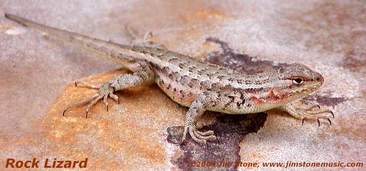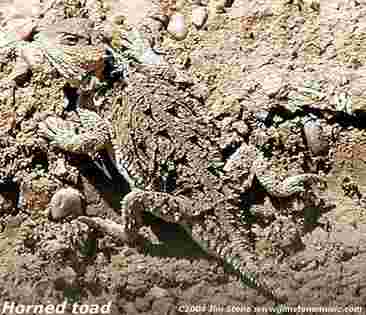 |   This colorful rock lizard Sceloporus occidentalis is a sub-species of the Eastern Fence Lizard found in the Eastern United States, but out west they are known as rock lizards.
Their colors are a little bit brighter and the pattern is slightly different from the Eastern fence lizard. These lizards can seem to fly up vertical rock faces; an ability afforded them by their nimble toes and needle sharp claws that can get into the smallest crevice. It is unusual to get a picture of one this good in the wild; a shot which was allowed me via a 300mm lens and a way with animals. Western fence lizards are fast and fierce predators of insects. On rare occasions they eat vegetation. They will eat any insect, including slugs and snails, which are not insects so I guess it's best said they will eat anything small that moves. Fence lizards can see very well and run very fast. They are extremely shy of people and most people can seldom get within 25 feet of one. I managed to get about 10 feet from this one, and let the lens do the rest. This lizard was a little less than 8 inches (20 centimeters) long. As you can see, its coloration is absolutely perfect for its surroundings, but it is not a chamelion. It just so happens to be the right color for its environment. These lizards can be almost impossible to see. Male fence lizards are very territorial and females are not. Females lay four to seventeen eggs which they will bury in any place where there is loose material that does not get disturbed and stays dry. The young will hatch about 10 weeks later. Horned (horny) toad / horned lizard
You don't see horned toads often, but on this day I saw two. I missed my chance to get a picture of the first one due to a cardinal sin - I left my camera in the car. This one I barely got a shot of. It darted out from the side of the road and I almost ran it over. I screeched the brakes while grabbing the camera and sprinted back to where it ran out just on time to catch a distant shot with a long lens on it's last pause before it went under a large rock. But still, at least I got something. Horned toads Phyrnosoma douglasii which are also known as horny toads are in fact lizards and can be found in the deserts and prairies of the central and western United States, and are a completely North American species. This particular horned toad is found only in the desert and is therefore called the Desert Horned Lizard Phrynosoma platyrhinos platyrhinos I photographed this one on the road to the BYU astronomical observatory on West Mountain, Utah County, Utah. Horned Lizards have many passive defense tactics, including the ability to make blood squirt out of their eyes. This for some reason makes them less appetizing to Coyotes and other predators. One tactic is also visible in the picture, they match their surroundings extremely well. I had an older camera with me on this day, and it really struggled with this picture because there is virtually no color depth, the horned lizard had no color difference between it and it's environment which caused the camera to not know it was there. I had to fix this image. I'd say camoflage is their number one defense. Another thing they will do is puff up, hiss and fake an attack, but are actually able to do nothing tangible to defend themselves, they bluff. Also notice how the horns on it's back (which give it it's name) closely match the texture of it's surroundings. This particular species of horned lizard is called the short horned lizard. This species can take the cold very well and gives birth to live young. New born young are very fast and agile, and can appear to be almost as fast as an adult. Horned toads feed mainly on ants, but will eat other insects such as crickets, beetles, grasshoppers, spiders and snails. For more pictures and stories of critters, visit the Main gallery References * Lizards, David Badger(text) John Netherton (photography); Voyageur Press 2002 (the photos on this site are my own, however) * Handbook of Lizards, Hobart M. Smith; Cornell University Press; 1967 * The Audibon Society Field Guide to North American Reptiles and Amphibians, John H. Behler and F. Wayne King; Alfred A. Knoph inc. 1979 * My own experience * Photography by Jim Stone, these photos are unique, do not copy and paste. |  |
 click the link for a better picture of this
click the link for a better picture of this  click the link for a better picture of this
click the link for a better picture of this